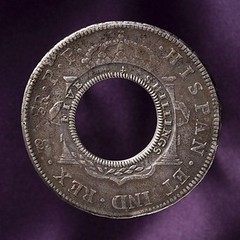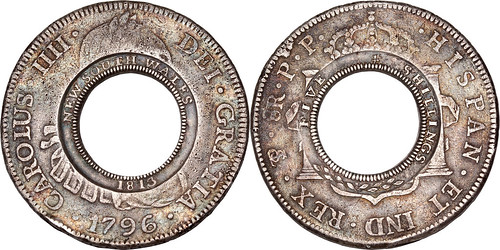
PREV ARTICLE
NEXT ARTICLE
FULL ISSUE
PREV FULL ISSUE
MORE ON HOLEY DOLLARSRegarding Dick Doty's question about the mint mark on the Holey Dollar acquired by the National Museum of Australia in Canberra, Ron Haller-Williams writes:It's Potosi !!! For my evidence, please go to www.nma.gov.au/collections/highlights/holey_dollar The obverse, near the top, seems to match the photo of the coin you speak of. The reverse, with "PTSI" monogram, is just over half-way down.


Ed Krivoniak agrees, and forwarded the image of the reverse of the coin.
Thanks! Shown above are obverse and reverse side-by-side.
-Editor
Adrián González Salinas compiled the following information. Thanks! The National Museum of Australia spent AUS$130,000 (hammer price AUS$111,000) to acquire a rare 1813 “holey dollar,” Australia's first official minted currency, at the International Auction Galleries' Australian & World Rare Coin auction on November 6th. There are only 300 or so holey dollars extant and this particular piece is one of only five which originated from Potosi, Bolivia. Source: http://www.thehistoryblog.com/archives/14157

The complete Holey Dollar (obverse and reverse): http://www.thehistoryblog.com/wp-content/uploads/2011/12/NSW-Holey-Dollar.jpg More Info: This Holey Dollar 1813 (1796/5) of the scarce Potosi Mint type and with fantastic old provenance sold for $129,315 http://iagauctions.com/files/IAG_A75_Review.pdf Also, I found the following and very interesting web site: www.australianstamp.com/coin-web/aust/earlyaus/holey$.htm which contains a Holey Dollar population by mint and year; including valuable information about this amazing coinage. Using the information of above web site I did some calculations about the 8 Reales host coins:
Lima, Peru - host coins from 1780-1810 - population: 30 holey dollars (10.87%)
To read the earlier E-Sylum article, see:
MUSEUM ACQUIRES 1813 NEW SOUTH WALES HOLEY DOLLAR
(www.coinbooks.org/esylum_v14n53a16.html)
The Numismatic Bibliomania Society is a non-profit organization promoting numismatic literature. See our web site at coinbooks.org. To submit items for publication in The E-Sylum, write to the Editor at this address: whomren@gmail.com To subscribe go to: https://my.binhost.com/lists/listinfo/esylum All Rights Reserved. NBS Home Page Contact the NBS webmaster 
|